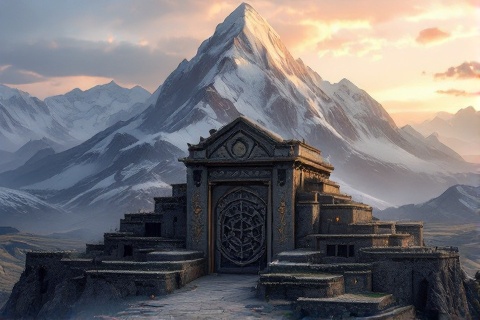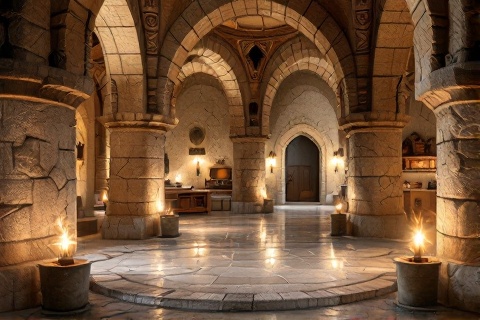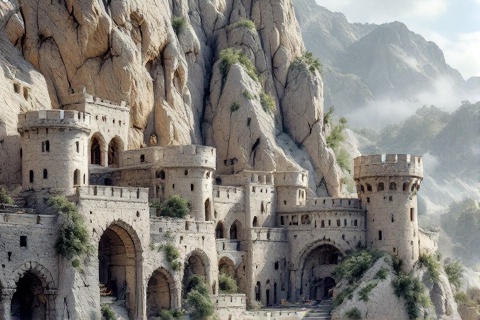
Erebor: The Lonely Mountain's Legacy
Unraveling the Rich History and Lore of the Dwarven Kingdom
The Geographic Marvel of the Lonely Mountain

Erebor, the Lonely Mountain, rises in majestic isolation from the plains of
Rhovanion, standing as the greatest of all the dwarf-kingdoms in the northern
regions of Middle-earth. This solitary peak towers above
the surrounding landscape, visible for many leagues in all directions and
serving as a beacon of dwarven might throughout the Third Age.
Its distinctive silhouette against the eastern sky earned it the well-known name
of the Lonely Mountain, for no other peak of comparable size exists within
hundreds of miles of its location.
The mountain's position near the junction of the Running River and Long Lake
proved crucial to its prosperity and strategic importance. The Running River,
known to the dwarves as Celduin, provided both a natural defense and a vital
trade route connecting Erebor to the settlements of Lake-town and beyond. This
waterway facilitated commerce with the realms of Men and
Elves, contributing significantly to the kingdom's wealth and
influence in the region.
The natural defenses of Erebor made it an almost impregnable fortress when
properly manned. The mountain's steep slopes and treacherous approaches limited
access to a few well-guarded paths, while its southern spur contained the only
entrance suitable for regular use. The harsh geography surrounding the mountain
created natural bottlenecks that allowed even a modest garrison to defend
against much larger forces effectively.
The Great Gates of Erebor

The Great Gate of Erebor, set into the mountain's southern spur, stood as a
masterpiece of dwarven engineering and artistry. These massive doors, wrought
from thick stone and reinforced with heavy metals, could withstand tremendous
force while still operating smoothly on their carefully balanced hinges. The
gates were designed to be operated by sophisticated mechanisms that allowed them
to be quickly sealed in times of danger.
The entrance to Erebor displayed some of the finest examples of dwarven
craftsmanship in Middle-earth, with intricate runes telling the history of
Durin's Folk and geometric patterns symbolizing the
connection between the dwarves and the stone they worked. These decorative
elements were not merely ornamental but served to demonstrate the skill and
artistry of the dwarven craftsmen who called Erebor home.
The defensive system around the main gate incorporated multiple layers of
protection, utilizing the natural rock formations of the mountain. Guard
chambers were cunningly worked into the rock face, while arrow slits and murder
holes were positioned to cover every approach. The design allowed defenders to
rain down missiles upon any attacking force while remaining well-protected
behind the mountain's natural stone barriers.
The Great Hall of Thráin

The Great Hall of Thráin, the most impressive chamber within Erebor, showcased
the pinnacle of dwarven architecture and stonework. This vast space was carved
directly from the living rock of the mountain, with walls that rose so high that
their upper reaches were lost in shadow. The hall served as both throne room and
ceremonial space, where the King under the Mountain would hold court and receive
emissaries from other realms.
Massive stone pillars, each carved from a single piece of rock and adorned with
intricate geometric patterns, supported the hall's vaulted ceiling. These
columns, arranged in precise mathematical patterns, distributed the enormous
weight of the mountain above while creating a sense of grandeur and space that
impressed even the most seasoned travelers who beheld them.
The floor of the Great Hall consisted of polished stone slabs fitted together
with such precision that the seams were nearly invisible. When lit by torches
set in elaborate bronze sconces along the walls, the polished surface created
mirror-like reflections that multiplied the light throughout the vast space.
This effect gave the impression that precious gems were embedded within the
floor itself, adding to the hall's magnificence.
The Treasury Chambers
The legendary treasure vaults of Erebor lay deep within the mountain's heart,
protected by multiple layers of security and magical wards. These chambers,
constructed during the height of dwarven power, represented the culmination of
their expertise in both engineering and defensive design. The vaults could only
be accessed through a series of heavily guarded corridors and chambers, each
with its own set of security measures.
Within these secure chambers, the dwarves developed sophisticated systems for
organizing and storing their vast wealth. Different vaults were designated for
various types of treasure: some held coins of gold and silver, others contained
precious gems sorted by type and quality, while still others protected ancient
artifacts of cultural and historical significance. Each storage area was
carefully climate-controlled to prevent deterioration of its contents.
The construction of the vaults themselves showcased the highest achievements of
dwarven craftsmanship. The walls were reinforced with special alloys known only
to the most skilled dwarven metalworkers, while the doors featured complex
locking mechanisms that required specific combinations of actions to open. The
sophistication of these security measures contributed to the vaults' reputation
as being virtually impenetrable.
Living Quarters and Common Areas

The residential areas of Erebor spread across multiple levels within the
mountain, arranged in a logical hierarchy that reflected dwarven social
structure. The royal family occupied the upper levels, closest to the surface,
while noble families and master craftsmen resided in the middle tiers. Common
living quarters were arranged in neighborhoods based on craft guilds and family
associations, creating distinct communities within the larger kingdom.
The workshops and craft halls represented the heart of dwarven industry and
creativity in Erebor. Each craft had its dedicated space, from the forges of the
weaponsmiths to the delicate workrooms of the jewelers. These areas were
carefully designed to provide optimal conditions for each craft, with
specialized ventilation systems, lighting arrangements, and storage facilities
tailored to specific needs.
The communal spaces of Erebor fostered the strong social bonds that
characterized dwarven society. Great feast halls could accommodate hundreds of
diners, while smaller gathering rooms provided spaces for guild meetings,
celebrations, and storytelling. These areas featured long tables carved from
stone, intricate wall carvings depicting dwarven history, and excellent
acoustics for music and singing, which played an important role in dwarven
culture.
The Mountain's Infrastructure
The ventilation system of Erebor represented a remarkable feat of dwarven
engineering, with a complex network of shafts and chimneys that maintained fresh
air throughout the mountain. These passages were designed to create natural air
circulation, drawing fresh air from the mountain's peak and expelling stale air
through carefully positioned vents. The system proved particularly crucial for
the forges and workshops, where proper ventilation was essential for both
comfort and safety.
The kingdom's water management system tapped into natural underground springs
and utilized a series of reservoirs and channels to distribute clean water
throughout the mountain. Clever engineering ensured a constant flow of fresh
water to all levels of the kingdom, while waste water was efficiently channeled
away through separate systems. The dwarves also maintained emergency water
reserves in sealed cisterns throughout the mountain.
Erebor's extensive storage facilities ensured the kingdom could survive extended
periods of isolation if necessary. Vast chambers were dedicated to storing
grain, preserved meats, and other provisions, with sophisticated systems to
maintain proper temperature and humidity levels. These storage areas were
regularly rotated and replenished to maintain fresh supplies.
The mining operations of Erebor featured an extensive network of tunnels and
specialized facilities for processing ore. The dwarves developed efficient
systems for extracting and processing various minerals, with dedicated areas for
crushing ore, smelting metals, and refining precious materials. These mining
operations were carefully planned to maintain the mountain's structural
integrity while maximizing access to valuable mineral deposits.
Defensive Features

The defensive infrastructure of Erebor included carefully positioned battlements
and watch posts that provided clear views of all approaches to the mountain.
These positions were equipped with signal systems that could quickly alert the
entire kingdom to any threat, while their construction allowed defenders to
remain protected while monitoring the surrounding territory. The watch posts
were continuously manned, ensuring no approach to the mountain went unobserved.
Throughout Erebor, the dwarves constructed a network of secret passages and
hidden doors known only to the kingdom's most trusted members. These escape
routes provided alternative means of entering and exiting the mountain, crucial
for both defense and emergency evacuation. The passages were ingeniously
concealed, with entrances disguised as ordinary rock faces or incorporated into
seemingly decorative elements.
Guard rooms and armories were strategically positioned throughout Erebor to
ensure rapid military response to any threat. These facilities stored weapons,
armor, and other military supplies in a state of constant readiness. The
armories were designed with efficient distribution systems that allowed the
kingdom's defenders to arm themselves quickly in times of need.
The internal defenses of Erebor included numerous narrow bridges and chokepoints
that could be easily defended by small groups against larger forces. These
defensive positions were carefully engineered to provide defenders with every
possible advantage, including elevated positions, cover, and multiple fallback
points. The design allowed the dwarves to control movement through the mountain
and effectively resist any force that managed to breach the outer defenses.
